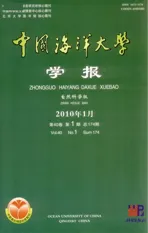高浓度钙离子胁迫对褐牙鲆幼鱼鳃黏液细胞数量、超微结构及分泌方式的影响
2010-09-13张灵燕张秀梅
张灵燕,张秀梅**,姜 明
(中国海洋大学1.海水养殖教育部重点实验室;2.海洋生命学院,山东青岛266003)
高浓度钙离子胁迫对褐牙鲆幼鱼鳃黏液细胞数量、超微结构及分泌方式的影响
张灵燕1,张秀梅1**,姜 明2
(中国海洋大学1.海水养殖教育部重点实验室;2.海洋生命学院,山东青岛266003)
利用光学显微镜和透射电子显微镜,研究了高浓度钙离子(37.5±0.1)mmol/L胁迫对褐牙鲆(Paralichthys olivaceus)幼鱼鳃黏液细胞数量、超微结构及分泌方式的影响。结果表明,高浓度钙离子组实验鱼鳃弓黏液细胞的数量与对照组无显著差异(P>0.05);高浓度钙离子组和对照组实验鱼鳃丝黏液细胞的超微结构相同,未成熟黏液细胞呈棒状,具发达的高尔基体和粗面内质网,细胞核近圆形,位于细胞底部,细胞顶膜在鳃上皮组织表面凹陷形成分泌腔,成熟黏液细胞体积较大,呈圆形,黏液颗粒排列紧密,充满整个细胞,基质密度大,细胞器位于细胞底部,细胞核形状不规则;高浓度钙离子组和对照组实验鱼鳃丝黏液细胞的分泌方式相同,均为顶浆分泌,但高浓度钙离子组实验鱼黏液细胞分泌活动旺盛,大量黏液正在向胞外排放,而对照组黏液细胞的黏液分泌量较少。研究认为,褐牙鲆幼鱼对高浓度钙离子胁迫具有较强的耐受能力。
Ca2+;褐牙鲆;黏液细胞;显微结构;超微结构
Ca2+是自然海水的重要组成部分,对鱼类的神经元兴奋性、肌肉收缩、细胞渗透性、细胞分化、激素释放和骨组织的矿物化等生理作用均具有重要影响[1]。已有研究表明,水中钙离子浓度是影响鱼体黏液细胞分泌和数量变化的重要环境因子[2]。研究发现,低浓度钙离子能够显著诱导莫桑比克罗非鱼(S arotherodon mossambicus)体表上皮组织中黏液细胞的增殖[3-4]。另据研究表明,低浓度钙离子能够刺激莫桑比克罗非鱼、革胡子鲶(Clarias lazera)和虹鳟(S almon gairdnert)黏液中钙调蛋白含量的显著增加,从而增强鱼体表皮的渗透调节能力[5]。但关于高浓度钙离子胁迫对鱼体黏液细胞的影响,目前尚未见报道。
黏液细胞(Mucous cells)是普遍存在于鱼类上皮中的1种腺体细胞,主要分布在鱼体皮肤、鳃及消化道的上皮中,其主要功能是分泌黏液,进而参与机体的呼吸、摄食、排泄、渗透调节和免疫等生命活动[6-7]。当鱼体受到外界胁迫时,其体表黏液细胞就会分泌大量黏液,保护鱼体免受外界损伤[8-10],因此黏液细胞的分泌方式与鱼体应对外界环境变化的能力密切相关。本研究以褐牙鲆(Paralichthys olivaceus)幼鱼为实验对象,研究了高浓度钙离子胁迫对褐牙鲆幼鱼鳃黏液细胞数量、超微结构及分泌方式的影响,以期为了解褐牙鲆幼鱼对高浓度钙离子胁迫的耐受能力及改善养殖环境提供参考。
1 材料与方法
1.1 实验材料
实验用褐牙鲆幼鱼购于山东文登小观镇养殖场,运回后置于实验室水槽(280 cm×175 cm×150 cm)中暂养2周。暂养期间,水温(18±0.3)℃,盐度30±0.5, pH=7.9±0.2,自然海水的主要离子浓度(mmol/L): Ca2+:9.7,Mg2+:49.4,SO2-4:25.4,Na+:415.2, Cl-:443.1,K+:11.3,连续充气,日换水率100%,每日06··00和18··00各投喂1次牙鲆专用颗粒配合饲料,日投饵量为幼鱼体质量的3%~4%,投喂后2 h及时吸除残饵及粪便。
1.2 实验设计
实验设定2个处理组:常规人工海水组(对照组)和高浓度钙离子人工海水组。常规人工海水使用曝气的自来水和海水素(青岛海大通用海水素有限公司生产)配制,主要离子浓度(mmol/L):Ca2+:10.3, Mg2+:51.1,SO2-4:24.9,Na+:425.9,Cl-:431.8, K+:12.1;高浓度钙离子人工海水使用曝气的自来水和无钙海水素配制,通过添加CaCl2分析纯调节Ca2+的浓度为(37.5±0.1)mmol/L,其他离子浓度与常规人工海水组相同,2个实验组盐度均为30±0.5,每日06··00和18··00测定Ca2+含量,出现波动,及时调节。
暂养结束后,随机选择50尾大小一致、健康活泼的褐牙鲆幼鱼(体长(160±40)mm,体质量(45±3) g),直接将实验鱼放入实验水槽内,每组25尾。实验期间的养殖管理与暂养期间完全相同。实验的取样时间为6,72,144和216 h。每次取样时从实验水槽中随机选取5尾幼鱼,取两侧鳃丝。
1.3 样品测定
1.3.1 组织切片的制作及鳃弓黏液细胞数量的计算在实验第72,144和216 h时,取对照组和高浓度钙离子组实验鱼鳃组织的鳃弓部分,切成0.5 cm3的组织块,用Bouin氏液固定24 h,然后用70%酒精冲洗;梯度乙醇脱水;石蜡包埋;切片厚度为4~5μm;苏木精-伊红染色;中性树胶封片;用Nikon,Eclipse LV100POL显微镜观察并进行显微拍照。黏液细胞数量的计算:使用Image J测量软件对鳃弓的长度进行测量,计算鳃弓单位长度内黏液细胞的个数(个/mm),每尾幼鱼观察10个视野(×400)内鳃弓黏液细胞的数量,即每个实验组统计50个视野内黏液细胞的平均个数。
1.3.2 透射电镜的制作 实验发现,将实验鱼放入高浓度钙离子水体后,实验鱼体表黏液分泌量在3~7 h异常增加。为观察前期应激阶段实验鱼黏液细胞超微结构的变化,在实验第6 h时(即前期应激阶段,鱼体表黏液分泌旺盛期),取对照组和高浓度钙离子组实验鱼鳃组织的鳃丝部分,切成0.5 mm3的组织块,置于5%的戊二醛溶液中,4℃下固定一周。用1%锇酸溶液固定1 h;梯度乙醇脱水;Epon-812渗透和包埋;经半薄切片定位,用L KB超薄切片机对鳃小叶进行超薄切片;常规电镜切片染色;用日产Hatachi,H-7000型电子显微镜观察并拍照。
1.4 数据分析
数据统计分析采用SPSS 11.5软件,用t-检验分析高浓度钙离子组与对照组鳃弓黏液细胞数量之间的差异显著性(P<0.05)。
2 观察结果
2.1 鳃弓黏液细胞数量的显微观察
在实验第72,144和216 h时,分别对对照组和高浓度钙离子组中鳃弓黏液细胞的数量进行了统计分析,见图1。由图1可以看出,实验期间,对照组和高浓度钙离子组鳃弓黏液细胞数量变化稳定,2组间无显著差异(P >0.05)。显微观察结果表明,对照组和高浓度钙离子组鳃弓表皮内并排分布着大量黏液细胞(见图版-Ⅰ)。

图版ⅠⅠ-1.常规人工海水组,鳃弓黏液细胞的数量;Ⅰ-2.高浓度钙离子人工海水组,72 h时鳃弓黏液细胞的数量;Ⅰ-3.高浓度钙离子人工海水组,144 h时鳃弓黏液细胞的数量;Ⅰ-4.高浓度钙离子人工海水组,216 h时鳃弓黏液细胞的数量MC:黏液细胞;B:血管道;cart:软骨Explanation of PlatesⅠⅠ-1.Normal artificial seawater,the number of musous cells in gill arch;Ⅰ-2.High calcium concentration artificial seawater,the number of musous cells in gill arch,72 h;Ⅰ-3.High calcium concentration artificial seawater,the number of musous cells in gill arch,144 h;Ⅰ-4.High calcium concentration artificial seawater,the number of musous cells in gill arch,216 hMC:mucous cell;B:blood channel;cart:cartilage

图版ⅡⅡ-1.鳃丝未成熟黏液细胞的完整结构标尺=1μm;Ⅱ-2.鳃丝成熟黏液细胞的完整结构标尺=2μm;Ⅱ-3.常规人工海水组,鳃丝黏液细胞排放初期标尺=2μm;Ⅱ-4.高浓度钙离子人工海水组,鳃丝黏液细胞排放初期标尺=1μm;Ⅱ-5.高浓度钙离子人工海水组,鳃丝黏液细胞排放末期标尺=1μm;Ⅱ-6.高浓度钙离子人工海水组,鳃丝黏液细胞排放末期细胞内空泡结构(V)的高倍图像标尺=3μmG:高尔基体;RER:粗面内质网;C:分泌腔;N:细胞核;PVC:扁平上皮细胞;M:黏液;V:空泡;白色星号:黏液颗粒PlatesⅡⅡ-1.The integrity structure of the immature mucous cell in gill filament,Scale bar=1μm;Ⅱ-2.The integrity structure of the well-developed mucous cell in gill filament,Scale bar=2μm;Ⅱ-3.Normal artificial seawater,the early stage of the secretory mucous cell in gill filament,Scale bar=2μm;Ⅱ-4.High calcium concentration artificial seawater,the early stage of the secretory mucous cell in gill filament,Scale bar=1μm;Ⅱ-5.High calcium concentration artificial seawater,the final stage of the secretory mucous cell in gill filament,Scale bar=1μm;Ⅱ-6.High calcium concentration artificial seawater,the high magnification image of vacuoles(V)in the final stage of the secretory mucous cell in gill filament,Scale bar=3μmG:Golgi apparatus;RER:rough endoplasmic reticulum;C:prominent crypt;N:nucleus;PVC:pavement cell;M:mucus;V:vacuole;white asterisk:mucous granules

图1 高浓度钙离子胁迫对褐牙鲆幼鱼鳃弓黏液细胞数量(个/mm)的影响Fig.1 Effects of high calcium concentration stress on number of mucous cells(number/millimetre)in gill arch of juvenileP.olivaceus
2.2 鳃丝黏液细胞的超微结构
电镜观察结果显示,黏液细胞主要位于鳃弓和鳃丝上皮组织内,在鳃丝上皮内的黏液细胞通常分布在氯细胞周围。对照组与高浓度钙离子组鳃丝电镜切片中均可观察到未成熟与成熟黏液细胞,其超微结构观察结果如下:
2.2.1 未成熟黏液细胞 电镜观察结果表明,对照组与高浓度钙离子组未成熟黏液细胞的超微结构相同。未成熟黏液细胞,体积较小,呈棒状;少数黏液颗粒分布在细胞顶部;细胞核位于基底部,核体较大,呈圆形,异染色质主要沿核膜边缘聚集,未观察到核仁;高尔基体和粗面内质网发达,高尔基体凹面可见分泌小泡,粗面内质网沿膜边缘分布;细胞顶膜在鳃组织表面凹陷形成分泌腔(见图版Ⅱ-1)。
2.2.2 成熟黏液细胞 电镜观察结果表明,对照组与高浓度钙离子组成熟黏液细胞的超微结构相同。成熟黏液细胞,体积较大,呈圆形;黏液颗粒排列紧密,充满整个细胞;细胞顶膜平滑;基质密度大;细胞器位于细胞底部;细胞核形状不规则,未观察到核仁(见图版Ⅱ-2)。
2.3 鳃丝黏液细胞分泌方式的超微观察
实验发现,高浓度钙离子组实验鱼反应剧烈,进入实验水体3~7 h时,其体表分泌大量黏液,在鱼体表皮形成厚厚的黏液层,电镜结果显示,高浓度钙离子组实验鱼鳃丝黏液细胞分泌活动旺盛,大量黏液正在向胞外排放,而对照组黏液细胞的分泌量较少。高浓度钙离子组鳃黏液细胞的分泌方式与对照组相同,均为顶浆分泌。黏液细胞排放初期,细胞顶膜破裂,顶膜处几个相邻的黏液颗粒首先融合破裂并在胞内释放黏液,通过顶膜的开口将黏液排出体外,残留的黏液颗粒膜在胞内形成空泡结构(见图版Ⅱ-3,4)。黏液颗粒的排放按照一定的顺序进行,即首先排放细胞顶部和中心的黏液颗粒,接着排放细胞周边的黏液颗粒,最后排放细胞底部的黏液颗粒。黏液细胞排放末期,分泌腔扩大,胞内含有大量黏液和空泡结构(见图版Ⅱ-5,6)。
3 讨论
莫桑比克罗非鱼在适应海水的过程中,鱼体表皮黏液细胞的数量显著下降,研究发现,海水中的钙离子是影响黏液细胞数量变化的主要环境因子,与水体渗透压和高浓度的NaCl等因素无关,降低海水中钙离子浓度则能够刺激鱼体表皮黏液细胞的增殖[2-4]。研究证明,低浓度的钙离子能够刺激鱼体泌乳刺激素的分泌,从而诱导黏液细胞的增殖;高浓度的钙离子能够抑制鱼体泌乳刺激素的分泌,从而抑制黏液细胞的增殖[4,11]。本研究结果表明,高浓度钙离子胁迫216 h,褐牙鲆鳃弓黏液细胞的数量无显著变化(P>0.05)。分析认为,褐牙鲆具有较强的调节高浓度钙离子的能力,无需改变鳃弓黏液细胞的数量,便可应对外界环境中钙离子浓度的变化,同时也说明不同鱼类对钙离子浓度的调节能力不同。
当鱼体遭遇胁迫时,体表就会迅速分泌大量黏液,以应对外界环境的变化。电镜观察结果显示,实验鱼鳃丝黏液细胞的顶膜暴露在外面,可与外界环境直接接触,有利于黏液细胞对外界环境的变化及时做出应激反应。本实验观察到,在接触高浓度钙离子人工海水初期,褐牙鲆反应剧烈,鱼体出现抽搐现象,体表形成厚厚的黏液层,减少了鱼体对海水离子的通透性,是鱼体自我保护的重要机制。但电镜观察发现,高浓度钙离子胁迫对褐牙鲆幼鱼鳃丝黏液细胞的超微结构无显著影响。然而研究原油对斑尾小鲃(Puntius sophore)鳃上皮黏液细胞的毒性效应时发现,在致死剂量下暴露12 h,黏液细胞退化分解[12]。这说明不同胁迫条件及胁迫程度对鱼体黏液细胞超微结构造成的影响不同。
鱼体黏液细胞在胁迫条件下能够迅速排放大量黏液,因此其黏液的分泌方式与鱼体适应外界环境的能力密切相关。鱼类黏液细胞主要有3种分泌方式:局浆分泌(Merocrine secretion)[13]、顶浆分泌(Apocrine secretion)[14-16]和全浆分泌(Holocrine secretion)[17-18]。研究表明,在正常情况下,哺乳动物肠道等黏液细胞一般采用局浆分泌持续分泌少量黏液,满足机体的正常需要[19],当受到外界刺激时,机体黏液细胞则通过顶浆分泌或全浆分泌迅速分泌大量黏液,满足机体的应激需求[20]。本研究结果表明,褐牙鲆幼鱼鳃丝黏液细胞在高浓度钙离子人工海水和常规人工海水中的分泌方式相同,均为顶浆分泌,但在高浓度钙离子胁迫条件下实验鱼鳃黏液细胞的分泌活动旺盛,大量黏液正在向胞外排放,且其分泌特点与其他鱼类的顶浆分泌不完全相同[14-16]。主要表现为:(1)黏液的排放并未仅局限于细胞的顶部,分泌腔随着黏液的不断排出而逐渐扩大;(2)黏液颗粒直接在胞内破裂并释放黏液,无需向细胞顶部移动,节省了黏液排放的时间;(3)黏液排放末期大量空泡堆积在胞内,细胞有收缩复原现象,这与哺乳动物肠黏液细胞分泌规律相似[20],因此作者推测,胞内残留的空泡可能参与黏液细胞顶膜的修复; (4)黏液颗粒的排放按照一定顺序进行。根据不同分泌时相的电镜观察,作者建立了褐牙鲆幼鱼鳃丝黏液细胞黏液排放过程模式图(见图2)。分析认为,褐牙鲆鳃丝黏液细胞的分泌特点与其较强的环境适应能力相关,但关于其他鲆鲽类是否具有相同的分泌特点有待于进一步研究。

图2 褐牙鲆幼鱼鳃丝黏液细胞黏液排放过程模式图Fig.2 Schematic representation of secretory process of the mucous cells in the gill filament of juvenileP.olivaceus
鲆鲽类是近岸底栖性鱼类,盐度、溶氧、p H、海水中离子组成及浓度变化等是影响其生长和成活的重要环境因子,对此已有许多研究报道,主要集中在生长、生理调节、免疫应答等方面[21-23],而环境胁迫条件下鱼体内化学物质的形成及排放过程等方面的研究相对薄弱。本研究结果表明,高浓度钙离子胁迫对鳃弓黏液细胞的数量、超微结构无显著影响,黏液细胞均以顶浆分泌方式分泌黏液,但高浓度钙离子组实验鱼黏液细胞分泌旺盛,大量黏液向体外排放,使鱼体表面形成一个保护层,从而增加了褐牙鲆对高浓度钙离子胁迫的耐受能力。因此,深入研究褐牙鲆鳃黏液细胞黏液的形成及排放规律,对了解鲆鲽类渗透调节机制和鱼体防御机能具有重要意义。
[1] Kaneko T,Hirano T.Role of prolactin and somatolactin in calcium regulation in fish[J].J Exp Biol,1993,184:31-45.
[2] Wendelaar Bonga S E.The effects of changes in external sodium, calcium,and magnesium concentrations on prolactin cells,skin, and plasma electrolytes ofGasterosteus aculeatus[J].Gen Comp Endocrinol,1978,34:265-275.
[3] Wendelaar Bonga S E,Van der Meij J C A.Effect of ambient osmolarity and calcium on prolactin cell activity and osmotic water pemeability of the gills in the teleostSarotherodon mossambicus [J].Gen Comp Endocrinol,1981,43(4):432-442.
[4] Wendelaar Bonga S E,Meis S.Effects of external osmolality,calcium and prolactin on growth and differentiation of the epidermal cells of the cichlid teleostSarotherodon mossambicus[J].Cell Tis-sue Res,1981,221:109-123.
[5] Flik G,Van Rijs J H,Wendelaar Bonga S E.Evidence for the presence of calmodulin in fish mucus[J].Eur J Biochem,1984, 138:651-654.
[6] 杨桂文,安利国.鱼类黏液细胞研究进展[J].水产学报,1999, 23(4):403-408.
[7] Shephard K L.Functions for fish mucus[J].Reviews in Fish Biology and Fisheries,1994,4(4):401-429.
[8] Fagan M S,O’Byrne-Ring N,Ryan R,et al.A biochemical study of mucus lysozyme,proteins and plasma thyroxine of Atlantic salmon(Salmo salar)during smoltification[J].Aquaculture, 2003,222(1-4):287 300.
[9] Gabowski L D,LaPatra S E,Cain KD.Systemic and mucosal antibody response in tilapia,Oreochromis niloticus(L.),following immunization withFlavobacterium columnare[J].Journal of Fish Diseases,2004,27(10):573-581.
[10] Roberts S D,Powell M D.Comparative ionic flux and gill mucous cell histochemistry:effects of salinity and disease status in Atlantic salmon(Salmo salarL.)[J].Comparative Biochemistry and Physiology Part A,2003,134(3):525-537.
[11] Wendelaar Bonga S E,Van der Meij J C A.The effect of ambient calcium on prolactin cell activity and plasma electrolytes inSarotherodon mossambicus(Tilapia mossambica)[J].General Comparative Endocrinology,1980,40(4):391-401.
[12] Prasad M S.Histochemical observation oncrude oil poisoning in the respiratory epithelium ofPuntius sophore[J].Acta hydrochim hydrubiol,1987,15(5):535-539.
[13] Díaz A O,García A M,Devincenti C V,et al.Mucous Cells in Micropogonias f urnierigills:Histochemistry and Ultrastructure [J].Anat Histol Embryologia,2001,30(3):135-139.
[14] Whitear M.The skin surface of bony fishes[J].Journal of Zoology London,1970,160:437-454.
[15] Perera K M L.Ultrastructure of the primary gill lamellae of Scomber australasicus[J].Journal of Fish Biology,1993,43 (1):45-59.
[16] 乔志刚,陈生智,程鸿轩,等.鲇肠道黏液细胞的类型、分布、发育及分泌方式研究[J].分子细胞生物学报,2007,40(1):24-30.
[17] Luchtel D L,Martin A W,Deyrup-Olsen I.Ultrastructural and permeability characteristics of the membranes of mucous granules of the hagfish[J].Tissue and Cell,1991,23(6):939-948.
[18] 陆宏达,朱光来,张连义,等.异育银鲫上皮瘤中黏液细胞类型、分布和分泌方式[J].动物学杂志,2008,43(4):85-91.
[19] Neutra M R,Grand R J,Trier J S.Glycoprotein synthesis, transport,and secretion by epithelial cells of human rectal mucoua:normal and cystic fibrosis[J].Lab Invest,1977,36:535-547.
[20] Freeman J A.Goblet Cell Fine Structure[J].Anat Rec,1966, 154(1):121-147.
[21] Boeuf G,Payan P.How should salinity influence fish growth [J].Comparative Biochemistry and Physiology Part C,2001, 130(4):411-423.
[22] Imsland A K,Gústavsson A,Gunnarsson S,et al.Effects of reduced salinities on growth,feed conversion efficiency and blood physiology of juvenile Atlantic halibut(Hippoglossus hippoglossusL.)[J].Aquaculture,2008,274:254-259.
[23] 王文博,李爱华.环境胁迫对鱼类免疫系统影响的研究概况[J].水产学报,2002,26(4):368-374.
Abstract: The effects of high calcium concentration stress on number,ultrastructure and secretory process of mucous cells in the gill of juvenileParalichthys olivaceuswere investigated by light microscope and transmission electron microscopy(TEM).The results showed that there was no significant difference in the number of mucous cells in gill arch between high calcium concentration group and control group(P >0.05).No difference in untrastructure of mucous cells in gill filament between the two experimental groups was observerd.Immature mucous cell was club-shaped and contained developed Golgi apparatus and rough endoplasmic reticulum.The nucleus was round and located in the base of the cell and the prominent crypt was curved in the surface of the gill epithelial tissue.Well-developed mucous cell was round and bigger than immature cell.The cell was filled with mucous granules and the whole organelles were compressed in the basal part of the cell.The cytoplasmic regions were electron dense and the nucleus was irregular.The secretory process of mucous cells in gill filament was same between the two experimental groups,belonging to apocrine secretion.However,the secretory activity of mucous cells was vigorous with discharging massive mucus in high calcium concentration group,while it’s weak in control group. The results indicated that juvenileP.olivaceushad strong tolerance of high calcium concentration stress.
Key words: Ca2+;Paralichthys olivaceus;mucous cell;microstructure;ultrastructure
责任编辑 于 卫
Effects of High Calcium Concentration Stress on Number,Ultrastructure and Secretion of Mucous Cells in Juvenile Paralichthys olivaceus Gill
ZHAN G Ling-Yan1,ZHAN G Xiu-Mei1,J IANG Ming2
(Ocean University of China 1.The Key Laboratory of Mariculture,Ministry of Education;2.Colloge of Marine Life Sciences,Qingdao 266003,China)
S917.4
A
1672-5174(2010)09Ⅱ-076-07
国家科技支撑计划课题(2006BAD09A15);国家自然科学基金项目(30600462)资助
2009-09-14;
2010-04-13
张灵燕(1983-),女,硕士生。E-mail:zhanglingyan2007@yahoo.com.cn
E-mail:gaozhang@ouc.edu.cn
